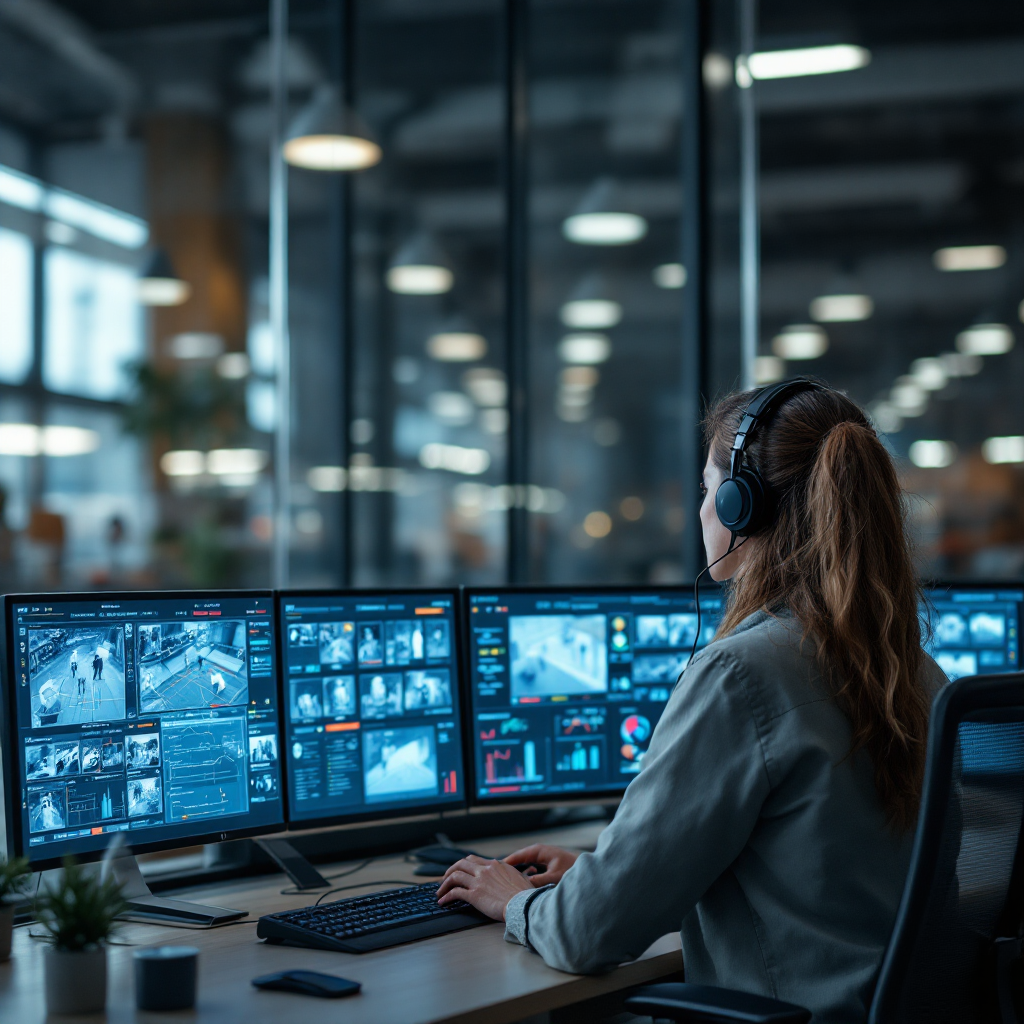The Basics of AI Video Analytics in Shopping Centres
AI Video Analytics blends computer vision and machine learning to turn video into searchable, actionable data. Unlike traditional CCTV that only records for later review, this approach detects people, classifies objects, and measures behavior in real time. For example, a modern feed can classify age and gender buckets, build dwell-time charts, and produce heatmaps that reveal where shoppers pause. In contrast to legacy cameras that require manual review, AI reduces time to insight and surfaces valuable insights for mall operators.
First, AI uses computer vision models to spot objects and track movement. Next, machine learning refines those models on site-specific footage so accuracy improves with local data. Then, analytics report simple metrics such as people counting and dwell times. In addition, these metrics guide store layout changes and tenant decisions. Retailers and mall operators use that data to optimize placement, signage, and openings.
Furthermore, AI creates demographic profiles without storing identifiable faces. Therefore, shopping centres can understand footfall composition while meeting privacy needs. Additionally, Visionplatform.ai helps malls turn existing CCTV into a sensor network so operators do not rip and replace cameras. The platform integrates with VMS and streams events to business systems for dashboards and BI. For a deeper look at retail-focused deployments, see our page on AI video analytics for retail.
Moreover, adoption has business implications. AI video analytics drives data-driven tenant mix planning and informs promotional placement. For broader market context, one industry analysis predicts rapid expansion of the AI video market to billions of dollars by 2033 (Grand View Research). Thus, malls that invest in intelligent video now can gain long-term competitive advantage.
Security and Safety: Video Surveillance Meets Video Analytics Solutions
Modern video surveillance pairs cameras with analytics engines to enhance physical security. AI-powered systems generate real-time alerts on incidents such as loitering, shoplifting, and unauthorized access. For example, automatic incident detection can notify security guards and trigger access controls immediately. These real-time alerts reduce response times and strengthen overall security.
Security teams see a measurable effect. In 2024, security and surveillance accounted for roughly 45.73% of the AI video analytics market revenue, highlighting demand for solutions that enhance security in retail settings (Mordor Intelligence). Additionally, intelligent video can flag perimeter breaches and detect suspicious behavior. This capability improves physical security without increasing the number of security guards on patrol.
Visionplatform.ai converts your existing security cameras into smarter sensors. The platform minimizes false alarms, keeps data on-prem to meet EU AI Act requirements, and streams structured events to MQTT for operational use. As a result, malls can integrate analytics with existing security systems and surveillance solutions while retaining control of their footage. This design helps teams make sure our security team receives timely, relevant alerts so they can act.
At one mall, integrating analytics cut shoplifting incidents and sped emergency response. Furthermore, a quoted industry note observes that AI in shopping centers “is not just about security; it’s about embracing the power of data to keep your shopping center ahead of the curve” (Flame Analytics). Finally, AI-powered systems help enforce access controls and detect unauthorized access across additional locations throughout the mall, improving response and resilience.

AI vision within minutes?
With our no-code platform you can just focus on your data, we’ll do the rest
Analysing Traffic Flow in a Shopping Mall with Video Analytics
Traffic flow maps and heatmaps reveal where shoppers move and where they stop. Heatmaps show high-traffic corridors and quiet corners, and people counting delivers entry and exit tallies. These tools let mall operators allocate staff, set opening hours, and design wayfinding. For retailers, these insights inform store layout and promotional placement to capture attention during peak times.
Also, video analytics supports queue detection and management. For example, measuring queue length at entrances and food courts reduces wait times and improves the shopping experience. Internal solutions also help with back-of-house flows such as loading dock access and safety. For specific implementations, see our write-up on people counting and heatmaps and related queue-management techniques for checkout lanes.
Moreover, analytics generate peak-hour profiles and movement patterns by hour and day. Consequently, mall operators can schedule staff better and create better tenant agreements. In addition, crowd modelling supports safety plans for events. For example, a high-traffic score may trigger dynamic signage and alternative routing to avoid congestion.
Finally, sensor fusion of cameras with Wi‑Fi or beacons refines accuracy. Therefore, combining data sources improves operational metrics and helps optimize traffic flow. In practice, this leads to better allocation of cleaning teams and security staff during busy hours. Overall, these tools raise operational efficiency and reduce friction for customers and staff, improving throughput and satisfaction.
Personalised Journeys in the Retail Store via AI-Powered Video Analytics
AI-powered video analytics enables targeted, in-store personalization that mirrors online retail tactics. Cameras feed anonymized signals into analytics engines to profile broad demographics, product interest, and repeat visits. Retailers can then tailor messaging on digital signs and adjust floor displays for better conversion. For example, demographic buckets can trigger offers for nearby shoppers without storing personal data.
Additionally, leveraging ai-powered video analytics can identify loyalty members who opt in to face-recognition or token-based identity. Then, staff receive a discreet cue to greet known members and provide curated service. This practice boosts the shopping experience and drives dwell time. In turn, retailers record higher basket sizes and improved conversion.
Also, in-store camera data informs product positioning and promotional timing. For instance, if analytics show a cluster around footwear, a retailer might reposition displays or add cross-sell signage. These changes optimize the store layout and increase engagement. For more on loss prevention and detection, consult our work on shoplifting detection with video analytics.
Furthermore, retail ai enables synchronized omni-channel campaigns. For example, an in-store interaction can trigger follow-up offers online. Consequently, malls can improve customer satisfaction and customer experience by crafting more relevant visits. Finally, these systems respect privacy by processing at the edge and keeping personal data controlled, a capability that Visionplatform.ai emphasizes in its platform design.

AI vision within minutes?
With our no-code platform you can just focus on your data, we’ll do the rest
Driving Profitability: Video Analytics for Retail and Retail Video Analytics Solutions for the Retailer
Video analytics for retail delivers clear ROI through increased sales and reduced costs. Retailers use cameras to measure conversion, monitor shelf engagement, and detect stock-outs. These actions translate into a measurable reduction in lost sales and inventory misplacement. In fact, AI adoption in retail has been shown to lift revenue and improve cost efficiency in recent industry reports (NVIDIA).
Retail video analytics solutions help brands optimize staffing and promotional timing. When occupancy rises, systems can call more staff to the floor. Conversely, quiet shifts can reduce staff presence without hurting service. This flexibility helps with staff allocation by the hour and supports better labor cost control.
Additionally, analytics to boost sales include measurement of engagement with endcaps and kiosks. A single metric that matters is conversion-per-visit, and cameras can help quantify it. In practice, retailers use this metric to refine merchandising and to decide which promotions to repeat. Also, platforms that integrate with POS and BI systems make these metrics actionable across teams.
Finally, retailers see a reduction in shrink through better detection and faster response. That reduction increases margins and lowers insurance costs. For practical guidance and retail-focused modules, review our shelf stock-out detection and loss-prevention resources. As a result, retailers and mall operators gain business intelligence that drives customer success and sustained profitability.
Future Trends: AI in Shopping Mall Analytics
The AI video analytics market shows strong growth. The global AI video market was valued at about USD 3.86 billion in 2024 and could reach USD 42.29 billion by 2033, reflecting a CAGR above 30% (Grand View Research). Therefore, innovation will accelerate across analytics in retail and surveillance solutions.
Emerging features include emotion detection, shelf-stock monitoring, and wider use of edge computing to keep data local. Edge computing reduces latency and helps organizations meet privacy rules such as the EU AI Act. Consequently, enterprises will prefer on-prem or hybrid models that let them own their data and models. In addition, AI-driven automation will expand in areas like loss prevention and dynamic wayfinding.
Meanwhile, notable deployments make headlines. For instance, reports state that america deploys ai-powered video analytics in major venues and that mall of america deploys ai-powered systems in pilot programs to monitor large crowds. These examples show scale and ambition. Furthermore, the industry will balance innovation with regulation, focusing on privacy, data governance, and auditability.
Finally, companies such as Visionplatform.ai position to support this shift by offering plug-and-play integrations with leading VMS and edge hardware. The goal is to keep analytics useful and compliant. As analytics to boost performance evolve, malls should prepare policies, update access controls, and train staff so an automated system improves safety while preserving shopper trust.
FAQ
What is AI video analytics and how does it differ from CCTV?
AI video analytics uses computer vision and machine learning to analyze live feeds and extract structured events. In contrast, CCTV typically records footage for later manual review without automated insights.
Can AI analytics improve mall security without storing personal data?
Yes. Many solutions process video at the edge and use anonymized descriptors instead of identifiable images. This approach balances physical security with privacy and compliance.
How do malls measure traffic flow with cameras?
Malls use heatmaps, people counting, and entry/exit tallies to map movement patterns. These metrics help optimize staffing and reduce queues during peak hours.
Will video analytics help reduce shoplifting?
Yes. Analytics can flag suspicious behavior, provide real-time alerts, and speed the response of security guards. That capability often results in a measurable reduction in shrink.
Are there integrations with existing VMS and POS systems?
Most modern platforms support common VMS protocols and can stream events to BI systems and POS via MQTT or webhooks. This integration enables unified operational metrics.
How does AI affect in-store customer experiences?
AI enables personalized messaging, improved store layout, and targeted offers tied to customer segments. These changes increase dwell time and can improve conversion when done with consent.
What future features should malls expect from AI analytics?
Expect more edge computing, emotion detection, and automated shelf monitoring. Additionally, AI-driven automation will support crowd management and dynamic signage.
How do providers ensure data compliance with the EU AI Act?
Providers can offer on-prem processing, transparent models, and auditable logs so data stays under customer control. These measures support GDPR and EU AI Act alignment.
Can analytics be used beyond security?
Absolutely. Analytics support tenant mix decisions, staff allocation, marketing measurement, and back-of-house operations like loading dock management.
How quickly can a mall deploy analytics to start seeing benefits?
Small pilots can run in weeks using existing cameras and plug-and-play edge devices. Then, scaling up and model tuning typically follows a phased plan for measurable outcomes.

